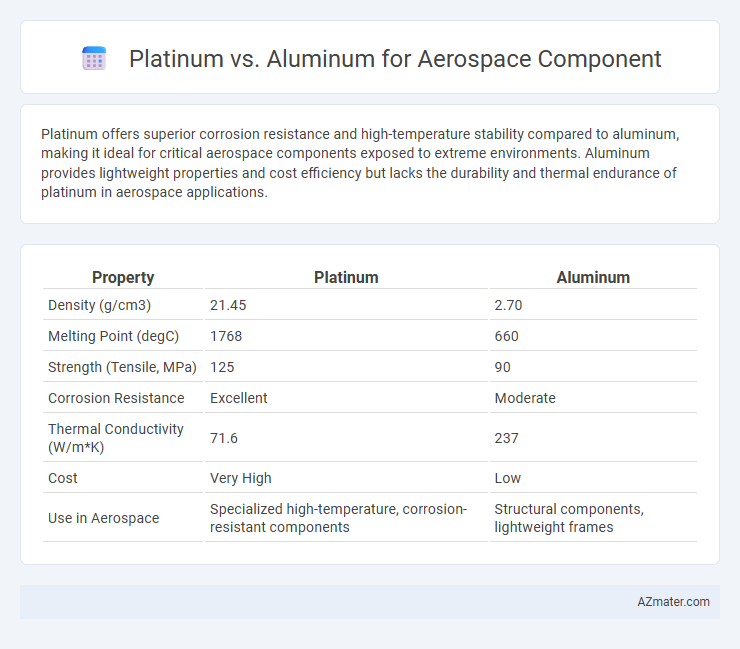Platinum offers superior corrosion resistance and high-temperature stability compared to aluminum, making it ideal for critical aerospace components exposed to extreme environments. Aluminum provides lightweight properties and cost efficiency but lacks the durability and thermal endurance of platinum in aerospace applications.
Table of Comparison
| Property | Platinum | Aluminum |
|---|---|---|
| Density (g/cm3) | 21.45 | 2.70 |
| Melting Point (degC) | 1768 | 660 |
| Strength (Tensile, MPa) | 125 | 90 |
| Corrosion Resistance | Excellent | Moderate |
| Thermal Conductivity (W/m*K) | 71.6 | 237 |
| Cost | Very High | Low |
| Use in Aerospace | Specialized high-temperature, corrosion-resistant components | Structural components, lightweight frames |
Introduction: Platinum vs Aluminum in Aerospace Engineering
Platinum and aluminum serve distinct roles in aerospace engineering due to their unique properties; aluminum is prized for its lightweight and high strength-to-weight ratio, making it ideal for structural components and airframe construction. Platinum's exceptional corrosion resistance, high melting point, and catalytic properties contribute to its use in specialized aerospace components such as engine parts and sensors. Material selection between platinum and aluminum hinges on performance requirements, with aluminum preferred for mass reduction and platinum chosen for extreme environmental durability.
Material Properties: Platinum and Aluminum Compared
Platinum exhibits exceptional corrosion resistance, high melting point (1,768degC), and superior strength, making it ideal for high-temperature aerospace components requiring durability and stability under extreme conditions. Aluminum, with a significantly lower melting point (660degC), offers excellent lightweight properties, good corrosion resistance through natural oxidation, and high strength-to-weight ratio, crucial for reducing aircraft weight and improving fuel efficiency. The choice between platinum and aluminum depends on balancing thermal resilience and weight constraints in aerospace applications.
Weight Considerations for Aerospace Applications
Platinum's high density at 21.45 g/cm3 makes it significantly heavier than aluminum, which has a density of approximately 2.70 g/cm3, influencing weight-critical aerospace components. Aluminum's lightweight properties contribute to improved fuel efficiency and payload capacity, whereas platinum's superior strength-to-weight ratio benefits specialized applications where durability outweighs weight concerns. Weight considerations in aerospace applications favor aluminum for structural components, while platinum is reserved for high-performance parts requiring exceptional corrosion resistance and thermal stability.
Strength and Durability Analysis
Platinum offers exceptional strength and corrosion resistance, making it ideal for aerospace components exposed to extreme temperatures and harsh environments. Aluminum provides a lightweight alternative with high strength-to-weight ratio, enhancing fuel efficiency but may require coatings to improve durability against oxidation and wear. The choice depends on specific performance requirements, with platinum excelling in durability and aluminum favored for weight-sensitive applications.
Corrosion Resistance Performance
Platinum offers superior corrosion resistance compared to aluminum, making it ideal for aerospace components exposed to harsh environmental conditions and chemical agents. Aluminum, while lightweight and cost-effective, is more susceptible to oxidation and requires protective coatings to prevent corrosion in corrosive atmospheres. The enhanced corrosion resistance of platinum significantly extends component lifespan and reduces maintenance requirements in aerospace applications.
Thermal Conductivity and Heat Management
Platinum and aluminum demonstrate significant differences in thermal conductivity and heat management critical for aerospace components. Aluminum offers high thermal conductivity (~237 W/m*K) enabling efficient heat dissipation, which is essential for maintaining optimal temperatures in aerospace applications. Platinum's lower thermal conductivity (~71.6 W/m*K) provides better heat retention but may require additional cooling systems, making aluminum more suitable for components requiring rapid heat transfer and thermal regulation.
Cost Analysis and Economic Impact
Platinum's high material cost and density make it less favorable than aluminum for aerospace components where weight reduction is critical and budget constraints are stringent. Aluminum offers superior cost-efficiency, widespread availability, and excellent strength-to-weight ratio, leading to significant savings in fuel consumption and overall operational expenses. The economic impact of using aluminum instead of platinum includes reduced manufacturing costs and enhanced aircraft performance, directly contributing to improved profitability for aerospace manufacturers.
Common Aerospace Uses of Platinum and Aluminum
Platinum is commonly used in aerospace components such as turbine blades, jet engine parts, and critical electrical contacts due to its excellent corrosion resistance, high melting point, and catalytic properties. Aluminum is extensively utilized in aircraft structures, including fuselage panels, wing assemblies, and landing gear components, because of its lightweight nature, high strength-to-weight ratio, and excellent fatigue resistance. The combination of platinum's durability in high-temperature environments and aluminum's strength and lightness makes both metals essential for different aerospace applications.
Environmental and Sustainability Factors
Platinum's high recyclability and resistance to corrosion significantly reduce environmental impact in aerospace components, contrasting with aluminum's widespread availability and lower energy consumption during extraction but higher oxidation rates. The lifecycle assessment of platinum alloys indicates superior durability leading to extended component lifespan and fewer replacements, enhancing sustainability through reduced waste generation. Aluminum's lightweight properties contribute to fuel efficiency, lowering carbon emissions during flight, but its mining and refining processes often result in higher ecological disturbance compared to platinum's more concentrated, lower-volume extraction.
Conclusion: Choosing the Right Material for Aerospace Components
Platinum offers exceptional corrosion resistance and high-temperature stability, making it ideal for critical aerospace components exposed to extreme conditions. Aluminum provides a lightweight solution with excellent strength-to-weight ratio and cost-effectiveness, favored in structures where weight reduction is paramount. Selecting the right material depends on balancing performance requirements, environmental factors, and budget constraints to ensure optimal aerospace component functionality and longevity.

Infographic: Platinum vs Aluminum for Aerospace Component
 azmater.com
azmater.com